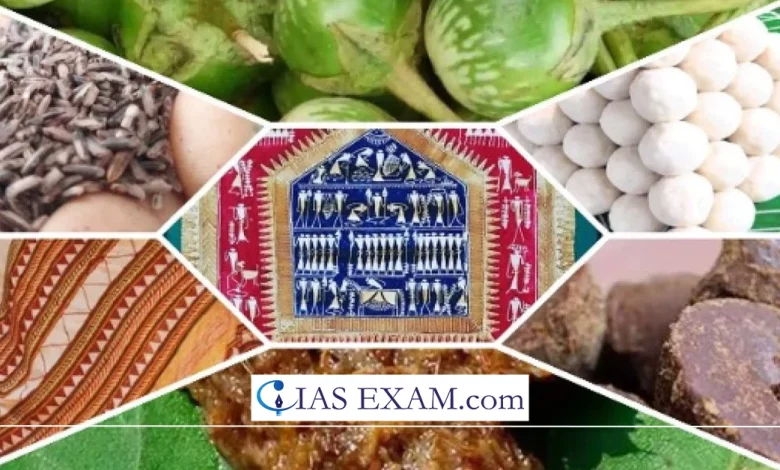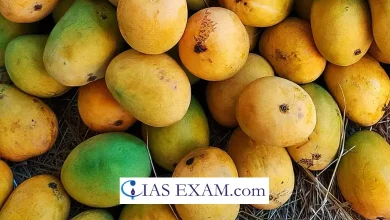Daily Current Affairs for UPSC
60 Traditional Indian Products Receive GI Tags
Syllabus: Government Policies and Interventions [GS Paper - 2]

Context
- One key thing that has happened is the approval of geographical indication (GI) tag to around 60 traditional Indian products from different regions of India, including the world famous B Manhattan Thandai.
- This, for the first time, the group of tags about which you are speaking is handed over for such a large number of products at one time according to One of the senior officials from the Geographical Indications registry.
About GI Tag
- The GI tag is often regarded in the Indian context as a significant device that supports stakeholders to develop and preserve traditional knowledge, culture and biodiversity.
- It performs the key function in the process of the rural economy rising by means of creation of the markets and increasing value of regional products.
- Moreover, the GI tag drives sustainable development through environment-conscious practices and preservation of all the elements of products linked to their area of production that are characteristic and unique.
- This niche, in its turn, achieves the main objective which is encouragement to consumers to cherish and value different peoples’ cultures, traditions, and folklore, and contributes to the preservation of cultural diversity and the creation of jobs to people involved in the craftsmanship.
Name of the Few Products of 60 list that received GI Tags
From Assam
- 1. Asharikandi Terracotta Craft: Traditional pottery of the Asharikandi region which has been passed down through generations as a local artefact.
- 2. Pani Meteka Craft: The art of specialised craft of hand Dhiva, where one can acquire exquisite items from the Pani Meteka.
- 3. Sarthebari Metal Craft: Famous for high quality brass and bronze products. Both metal wares were the most popular in the city.
- 4. Jaapi (Bamboo Headgear): The traditional hats made from bamboo leaves.
- 5. Mishing Handloom Products: Textiles that the Mishing community craft for their weaving rituals thus become a medium of expressing their regard for this tradition in the art exhibition.
- 6. Bihu Dhol: Deeply rooted in the Assamese identity, the traditional drum used for the Bihu celebration.
- 7. Bodo Dokhona: The Bodo women wear belongings traditionally.
- 8. Bodo Eri Silk: Textile made of rice moth’s cocoon, in Samia ricini, known as peace cloth.
- 9. Bodo Jwmgra: Associated with the Bodo ethnic group, it is a traditional scarf.
- 10. Bodo Gamsa: Traditional wear of Bodo people in the attire of men.
- 11. Bodo Thorkha: Bodo instruments becoming the main product for their culture.
- 12. Bodo Sifung: Hidden deep in a traditional Bodo culture is the long flute of Bodo music (bd mog).
From Varanasi
- 1. Banaras Thandai: Modern approach – a nut over us with dairy, nuts, seeds, as well as a variety of spices varieties.
- 2. Banaras Tabla: Banaras’ music culture is distinctly defined by the percussion instrument that has been existing since the time immemorial.
- 3. Banaras Shehnai: Traditional wind instruments represent the typical nature of Benaras.
- 4. Banarasi Lal Bharwan Mirch: Stuffed red chilipecitor from Banaras of a specific variety.
- 5. Banaras Lal Peda: Local specialty of Banaras is sweetened dessert made of milk with a higher concentration.
From Tripura
- 1. Pachra-Rignai: Known as the Meghalayan quintessence, the pat shakha women wear in Tripura.
- 2. Matabari Peda: The Red Pepper Cake, it’s a delicacy only prepared in the Matabari area.
From Meghalaya
- 1. Garo Textile Weaving: Weaving tools from the Garo community and traditional geometric patterns.
- 2. Lyrnai Pottery: An example of traditional pottery that is famous for its unique style of craft and performance.
- 3. Chubitchi: Local Liquor from Meghalaya alcoholic drink.
Conclusion
- The authenticity of more than sixty traditional items of India has been attained by the grant of GI (Geographical Indication) tags, a major turning point in preserving and popularising the glorious heritage of the country. Such tags which are used in the context of these products not only check them for authenticity and uniqueness but at the same time increase their economic value and their global recognition.
Source: The Hindu
UPSC Mains Practice Question
Q.Discuss the significance of Geographical Indication (GI) tags in promoting India’s cultural heritage and rural economy. Elaborate on the impact of GI tagging on traditional Indian products, citing examples from different regions. Assess the role of GI tags in preserving traditional knowledge and preventing exploitation of indigenous names and practices.





.png)



